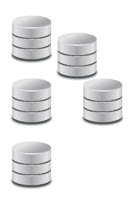Overview: What is "chain-free" backup?
 Axcient x360Recover chain-free backup starts off the same way as traditional chain-based backups. You still do your first full backup, and you still do incremental backups - but that’s where things change.
Axcient x360Recover chain-free backup starts off the same way as traditional chain-based backups. You still do your first full backup, and you still do incremental backups - but that’s where things change.
x360Recover captures snapshots of a server every few minutes and replicates those images to the Axcient Cloud. Those snapshots include data, operating system, applications, and configurations.
With Axcient chain-free backup, data is stored in a native virtualizable state with a pointer array algorithm.
With Axcient chain-free backup, each recovery point is independent:
 |
|
Related article:
How does traditional chain-based backup work?
Each full backup image (and its subsequent incremental backups) constitutes a “chain” of dependent recovery points.
- During a chain-based recovery, all of the backups must be consolidated - in the order in which they were created.
- Damaged data anywhere within the chain will cause all dependent recovery points to contain that corrupted data.
- All chain-based backup strategies require individual recovery points be merged together in a “rollup” process. This is needed to limit the total backup data size and to establish limits for the total retention period.
Processing the rollup of recovery points is inherently fragile and time consuming. Any errors during this process can cause a broken chain.
How failures happen in chain-based backupThe following steps typically occur in failed traditional chain-based backups:
Backup vocabularyEncryption: Backup data should always be encrypted end-to-end during network transmission, whether limited to the local LAN, or replicated to an off-site location. Data should also be encrypted at rest, on whatever storage media will ultimately contain the backup. Compression: This reversible process delivers a set of data which can be processed into a new form, occupying a smaller amount of storage space than the original. All backup solutions offer some form of data compression when capturing backup images. This is necessary in order to maximize the capacity of the underlying backup storage system.
Types of chain-based backupsFull (base) backup is a complete copy. Everything on the system is captured. Full backups are large and take a long time to capture and process, making them ideal when recovering data, since all files exist within one backup image. Synthetic full backup: Most modern backup solutions offer the ability to present a "synthetic full backup" when restoring files. This involves internally combining the most recent full backup along with all subsequent incremental backups, then presenting the compilation as if it was a single full backup for recovery purposes. Copy backup captures a full backup, but does not mark the file archive bits. A copy backup may be taken after a full backup and will not interfere with the integrity of differential or incremental backup jobs Differential backup contains everything that changed since the previous full backup was completed. Each differential backup will contain everything that has changed, including files already stored within previously taken differential backups. Differential backups are a compromise between full and incremental: you only need the most recent full and the most recent differential together in order to recover your data. Each successive differential backup is larger than the previous backup, because it contains all of the data captured in each previous differential plus any new changes. Image-based backup solutions generally do not offer the option of performing differential backups. Incremental backups contain only files that have changed since the last Incremental or full backup was completed. Incremental backups are small and allow for fast backup job processing. However, to fully reconstruct your data during recovery, the most recent full backup must be processed, in addition to every single incremental taken afterwards. Incremental forever backups occur when (a) a single full backup is initially taken and (b) all subsequent backup operations are performed as incremental backups. Individual incremental backup jobs may be collapsed, or “rolled up” into the previous backup in order to reduce retention and total number of recovery points. Forward incremental backups use the first full backup and the set of incremental backup files which then follow. The forward incremental backup includes any synthetic full and/or active full backup files that “split” the backup chain into shorter series. Reverse (inverse) incremental backups occur when new Incremental backups are first committed to the base image, and a “rollback” file is then created defining the changes just made to the base image. Reverse Incremental chains maintain the base image as the most recent backup, and produce a chain of progressively older Incremental recovery points. Reverse incremental backups are essentially similar to incremental backups, but can take longer to complete, because the new backup data first needs to be committed to the backup set and then the rollback file must be created. DeleteForward incremental-forever backups versus reverse incremental-forever backups
So, how is chain-free backup different?With chain-free backups, each subsequent backup performs a copy-on-write (for changed data only) to a consolidated storage pool. Copy-on-write means that changed blocks are written to a new storage location and the original block data is not overwritten. Performing a new full backup only writes new / changed blocks to the image and does not consume the data of the entire full system (which is what chain-based backup systems do.)
Data is never moved once it is written, so there is never any possibility of corrupting the underlying image. DeletePros and cons of chain-based backup
How do your choices in backup compare? Traditional forward chains are fragileTraditional chain backups are fragile. Over time, it is almost certain that a broken chain will eventually cause the backup set to become corrupted. To resolve a broken recovery point in a traditional chain, you'll need a completely new backup chain. DeleteReverse (inverse) chains are a little betterReverse (inverse) chain backups are a little better than traditional forward chain backups. Why? Because broken chains in a reverse backup only result in the loss of historical recovery points. The base image and recent backups are still accessible. Unfortunately, however, a broken chain in a reverse backup still means you cannot completely roll up all of your historical backups - and, of course, a new backup chain is still required to recover. Delete+Chain-free is bestChain-free backups are your best choice, because corrupted recovery points have no effect on the quality and reliability of your backups. Plus, you'll only need to create a new backup chain if the entire original backup set is lost. No time is wasted performing recovery point rollups. Delete |
Reminder: Review these backup best practices (no matter which method you choose)
By using an incremental-forever strategy, you eliminate the need to deliver large base images to your off-site data center on a regular basis. Also, creating backups with multiple base images is very data intensive. |
Always perform a new full (base) image whenever a protected system is recovered from backup. This ensures that the data image on the backup server matches the live protected system. |
Perform periodic recovery testing on all of your protected systems to ensure they are fully recoverable. This is especially true for chain-based solutions where it may not be obvious that you have a broken backup chain. |
|
|
Additional reading: |
SUPPORT | 720-204-4500 | 800-352-0248
- Contact Axcient Support at https://partner.axcient.com/login or call 800-352-0248
- Free certification courses are available in the Axcient x360Portal under Training
- Subscribe to the Axcient Status page for a list of status updates and scheduled maintenance
1272

 Steps in traditional forward-chain incremental-forever backups:
Steps in traditional forward-chain incremental-forever backups:  Steps in traditional reverse-chain incremental-forever backups:
Steps in traditional reverse-chain incremental-forever backups: